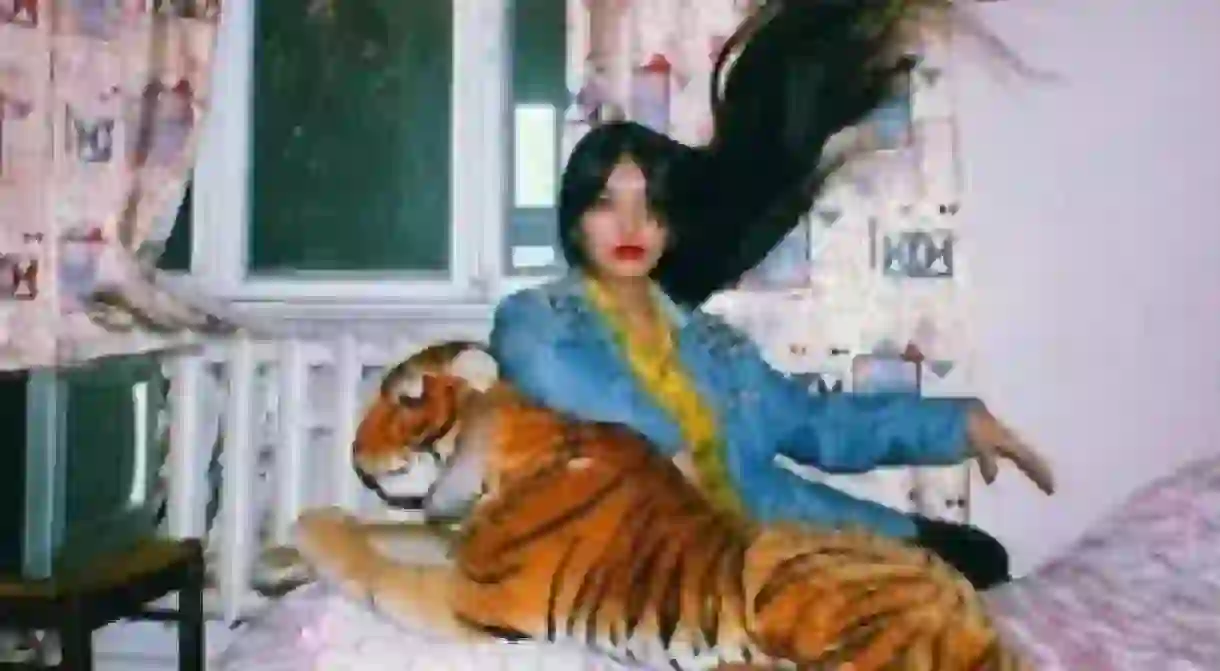The 8 Most Influential Women Revolutionising Central Asian and Caucasian Art

Since 2005, the world’s largest contemporary art event, the Venice Biennale, has welcomed a Central Asian pavilion. Despite the success of these exhibitions, Central Asia’s art and artists remain relatively unknown even among art lovers, a situation exacerbated by a lack of governmental support for cultural projects. These eight women, be they artists, collectors, curators or academics, are among the most influential in developing the exciting art scenes of the former Soviet states.

Almagul Menlibayeva
‘Romantic punk shamanism’ might not be a concept frequently explored in contemporary art, but it’s the term Almagul Menlibayeva uses to describe her diverse work. The artist, who now divides her time between her native Kazakhstan and Berlin, produces striking video, photography, performance and installation pieces; this diversity of medium is part of Menlibayeva’s methodology, as she attempts to expose the overwritten histories of post-Soviet nations such as Kazakhstan. Inspired by animism, shamanism and her Soviet Russian education in avant-gardism, Menlibayeva’s most striking works use the beautiful Kazakh Steppes as backdrops, playing out geopolitical power tussles on the bodies of female figures on the bleak, blasted plains. As the artist herself explains, the work ‘raises metaphysical questions such as “who am I?” and “where shall I go?”; this psychic experience and perspective marks my artistic language.’
Sara Raza
Independent writer, critic and curator Sara Raza is one of the most interesting and impassioned voices in the current discourse on Central Asian contemporary art. As ArtAsiaPacific’s editor for West and Central Asia, she brings the region’s art in from the cold, giving it critical space in a top-flight publication where you’re as likely to read about Ai Weiwei as you are Eurasian art collective Slavs and Tatars. Raza, a former curator of public programs at Tate Modern, is current reviews editor for Ibraaz and visiting lecturer for Sotheby’s MA program, as well as carrying out her own packed agenda of independent projects, working with artists such as Wafaa Bilal and Edge of Arabia to draw out the pan-continental links between Central Asian and Middle Eastern artists.

Aida Mahmudova
Not content with being a prominent artist, Aida Mahmudova is also one of Azerbaijan’s most important contemporary art movers and shakers. In 2011 she founded YARAT, the country’s best-known non-profit art space, the aim of which, says Mahmudova, is to support Azeri artists and to identify international platforms with which these artists can work. Since her first European solo show in 2013, Mahmudova has continued to make work that meshes various media, reflecting on modern Azerbaijan through a wash of nostalgia. As the niece of the current First Lady of Azerbaijan, Mahmudova splits her time between Baku and London, sparking connections between Central Asia and the international commercial art scene.

Annya Sand
At first glance, Annya Sand’s serene abstract paintings may appear to be far removed from the striking, strident work of Almagul Menlibayeva. But Sand, a fellow Kazakh artist, in fact has elements in common with her countrywoman: both are fascinated with and influenced by the steppes of their homeland; both make work richly organic in tone, scope and color; both left Kazakhstan for Europe, Menlibayeva for Berlin and Sand for London. But, it must be said, Sand’s paintings are softer, more conservative and calmer, the female figures imagined as ballerinas instead of pouting power-posers.

Gayane Umerova
Contemporary art lovers might not have heard of Gayane Umerova until her inclusion in 56th Venice Biennale when she was selected as chief curator of the inaugural Uzbekistan pavilion at the 2015 event. When not curating international biennales like the 6th Tashkent International Biennial of Contemporary Art, Umerova is the senior curator at the Art Gallery of Uzbekistan. Dividing her time between Tashkent and London, Umerova plays a vital role in promoting Central Asian artists on the commercial art scene, strengthening collector bases and helping set up selling exhibitions in the region.

Mila Askarova
Mila Askarova, Founder and Director of London’s Gazelli Art House, is what you might call an ‘art-repreneur’. Born and raised in Azerbaijan, she arrived in London to complete a degree at the London School of Economics and Political Science, going on to work at Sotheby’s in Client Development, and then the PR Department of a commercial London space, followed by some private art dealing. She also doubled up on the theory, studying at Central St Martins and Christie’s. This unusual formative period gave Askarova the ability to do something unique with Gazelli Art House, establishing a commercially viable space with non-profit ideals, an avowedly Azeri enterprise that also welcomes international artists. After holding various off-site exhibitions in 2011, Gazelli opened its London branch in 2012 and, later that year, fired up the Baku branch; both now focus strengthening academic credibility and building a roster of international, not just Azeri, artists.
Aza Shade
In the spirit of Almagul Menlibayeva, Aza Shade puts the shamanistic punk back into contemporary art. A photographer and filmmaker, singer and model, she levies all weapons in the artist’s armory to make her darkly humorous, often disturbing work. Shade, who grew up in Uzbekistan and Kyrgyzstan but relocated to London in 2006, mixes Central Asian visual clichés – onion domes, stuffed Siberian tigers – with icons of modern subculture, in particular her own tattooed body. Her work throws down these challenges to the art world. Elements of 1960s European avant-garde, the Theatre of the Absurd and the psychoanalysis, de-sexualized nudity and outré sexuality all inform her films and photographs.

Natalya Dyu
Natalya Dyu’s video work ‘Happystan’ encapsulates much of what is striking about her art and practice. Riven with irony and incongruity, the short film puts modern day Kazakhstan under the microscope, examining it unflinchingly but with a certain affection. Dyu, herself Kazakh with some Korean heritage, lives and works in Almaty, and is fully engaged with Kazakhstan’s social realities. Her work has appeared internationally, from India to Mexico, including at the Venice and Moscow Biennales.
Happystan by Natalya Dyu:













